SHR011-6: Personal Leadership Report - Style, Reflection & Growth
VerifiedAdded on 2023/06/13
|15
|3779
|140
Report
AI Summary
This report provides a comprehensive analysis of leadership styles, focusing on a personal reflection of leadership skills, strengths, and areas for improvement. It explores the application of the seven-mindset theory within the context of SPAR, an international food retail chain, and discusses the importance of proactive leadership in managing diverse teams. The report includes a CPD (Continuing Professional Development) plan, outlining strategies for present and future role development, and assesses the alignment of the author's leadership style with the organization's needs, particularly in supporting organizational change for 21st-century business success. The analysis reflects on the understanding of leadership, highlighting key conclusions and recommendations for personal and professional growth. Desklib provides a platform for students to access similar solved assignments and study resources to enhance their understanding of leadership concepts.
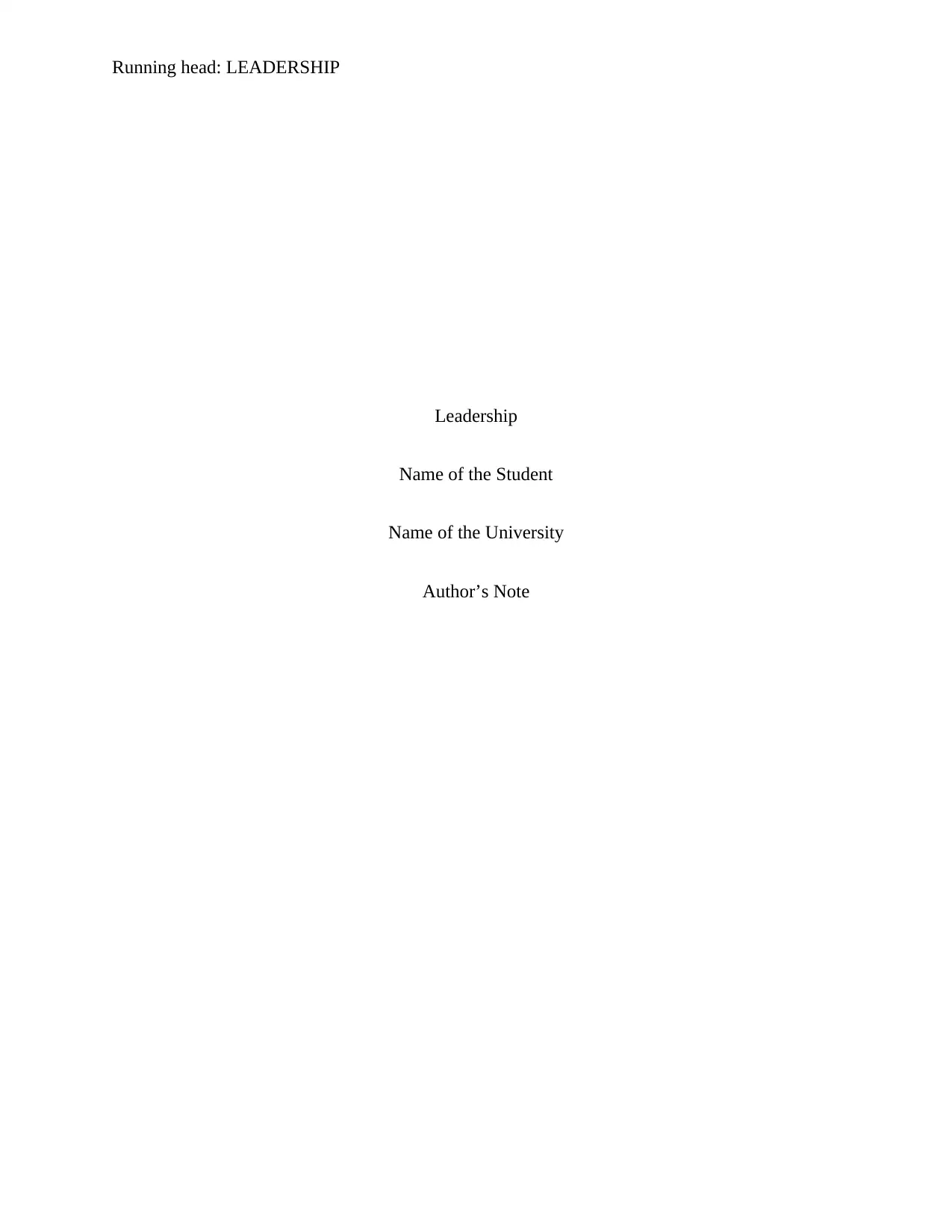
Running head: LEADERSHIP
Leadership
Name of the Student
Name of the University
Author’s Note
Leadership
Name of the Student
Name of the University
Author’s Note
Paraphrase This Document
Need a fresh take? Get an instant paraphrase of this document with our AI Paraphraser
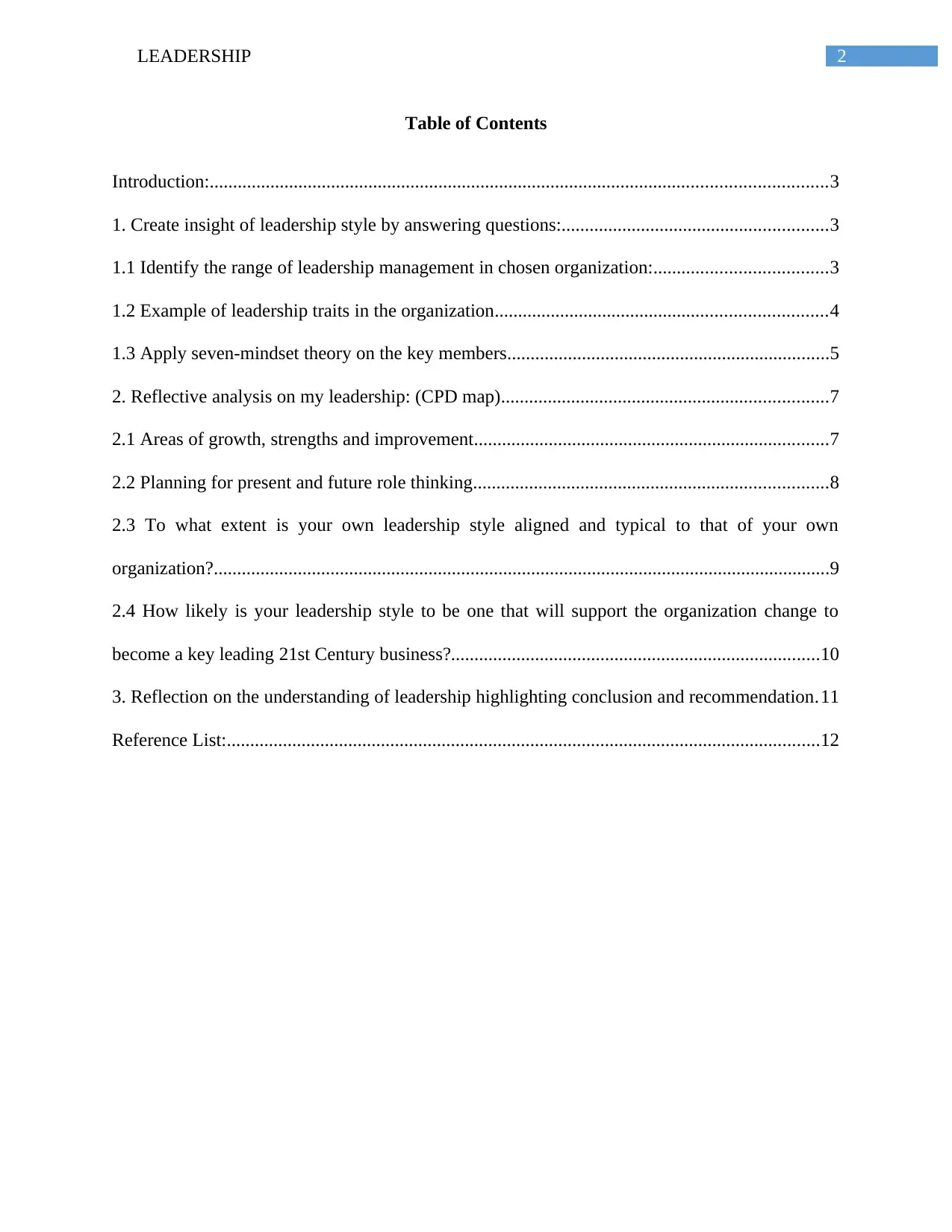
2LEADERSHIP
Table of Contents
Introduction:....................................................................................................................................3
1. Create insight of leadership style by answering questions:.........................................................3
1.1 Identify the range of leadership management in chosen organization:.....................................3
1.2 Example of leadership traits in the organization.......................................................................4
1.3 Apply seven-mindset theory on the key members.....................................................................5
2. Reflective analysis on my leadership: (CPD map)......................................................................7
2.1 Areas of growth, strengths and improvement............................................................................7
2.2 Planning for present and future role thinking............................................................................8
2.3 To what extent is your own leadership style aligned and typical to that of your own
organization?....................................................................................................................................9
2.4 How likely is your leadership style to be one that will support the organization change to
become a key leading 21st Century business?...............................................................................10
3. Reflection on the understanding of leadership highlighting conclusion and recommendation.11
Reference List:...............................................................................................................................12
Table of Contents
Introduction:....................................................................................................................................3
1. Create insight of leadership style by answering questions:.........................................................3
1.1 Identify the range of leadership management in chosen organization:.....................................3
1.2 Example of leadership traits in the organization.......................................................................4
1.3 Apply seven-mindset theory on the key members.....................................................................5
2. Reflective analysis on my leadership: (CPD map)......................................................................7
2.1 Areas of growth, strengths and improvement............................................................................7
2.2 Planning for present and future role thinking............................................................................8
2.3 To what extent is your own leadership style aligned and typical to that of your own
organization?....................................................................................................................................9
2.4 How likely is your leadership style to be one that will support the organization change to
become a key leading 21st Century business?...............................................................................10
3. Reflection on the understanding of leadership highlighting conclusion and recommendation.11
Reference List:...............................................................................................................................12
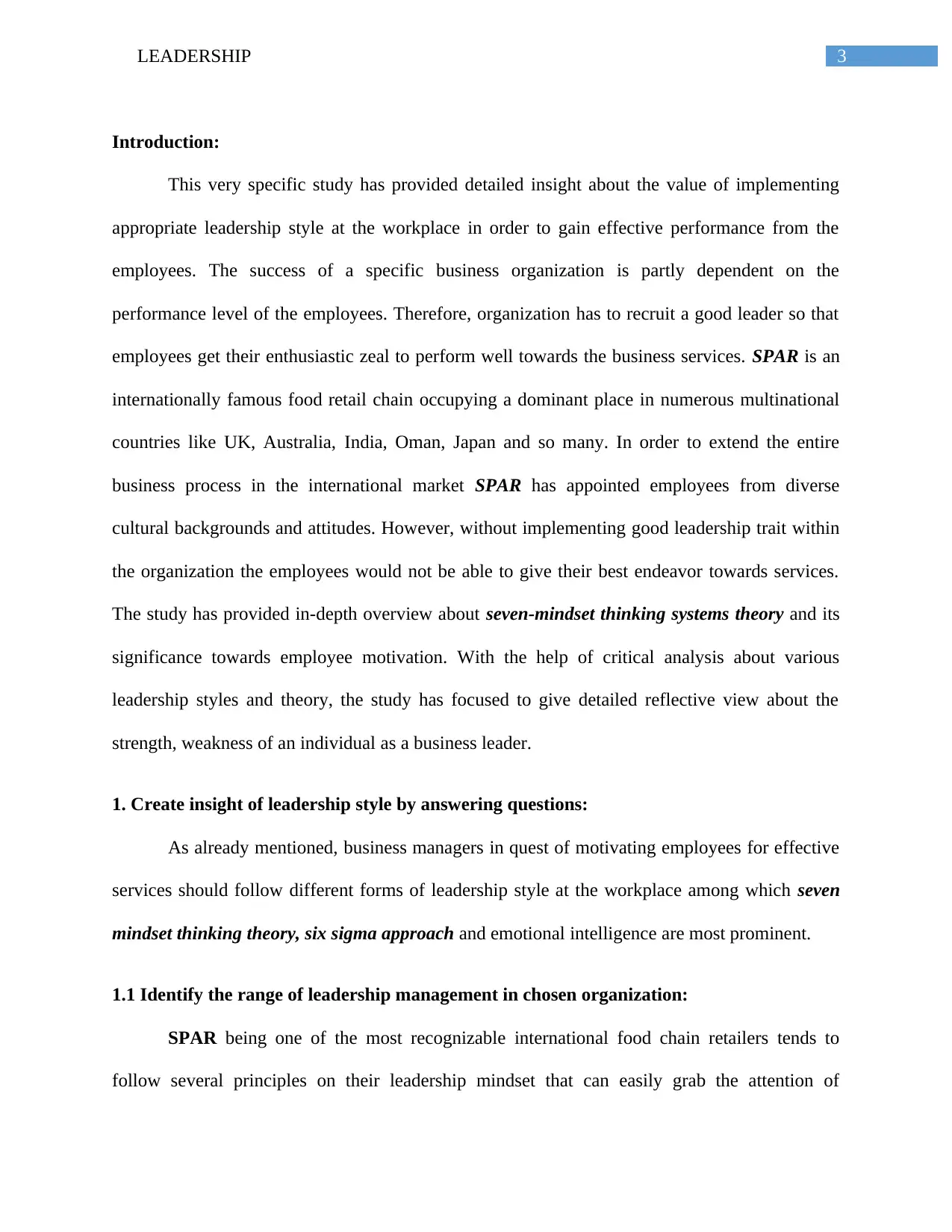
3LEADERSHIP
Introduction:
This very specific study has provided detailed insight about the value of implementing
appropriate leadership style at the workplace in order to gain effective performance from the
employees. The success of a specific business organization is partly dependent on the
performance level of the employees. Therefore, organization has to recruit a good leader so that
employees get their enthusiastic zeal to perform well towards the business services. SPAR is an
internationally famous food retail chain occupying a dominant place in numerous multinational
countries like UK, Australia, India, Oman, Japan and so many. In order to extend the entire
business process in the international market SPAR has appointed employees from diverse
cultural backgrounds and attitudes. However, without implementing good leadership trait within
the organization the employees would not be able to give their best endeavor towards services.
The study has provided in-depth overview about seven-mindset thinking systems theory and its
significance towards employee motivation. With the help of critical analysis about various
leadership styles and theory, the study has focused to give detailed reflective view about the
strength, weakness of an individual as a business leader.
1. Create insight of leadership style by answering questions:
As already mentioned, business managers in quest of motivating employees for effective
services should follow different forms of leadership style at the workplace among which seven
mindset thinking theory, six sigma approach and emotional intelligence are most prominent.
1.1 Identify the range of leadership management in chosen organization:
SPAR being one of the most recognizable international food chain retailers tends to
follow several principles on their leadership mindset that can easily grab the attention of
Introduction:
This very specific study has provided detailed insight about the value of implementing
appropriate leadership style at the workplace in order to gain effective performance from the
employees. The success of a specific business organization is partly dependent on the
performance level of the employees. Therefore, organization has to recruit a good leader so that
employees get their enthusiastic zeal to perform well towards the business services. SPAR is an
internationally famous food retail chain occupying a dominant place in numerous multinational
countries like UK, Australia, India, Oman, Japan and so many. In order to extend the entire
business process in the international market SPAR has appointed employees from diverse
cultural backgrounds and attitudes. However, without implementing good leadership trait within
the organization the employees would not be able to give their best endeavor towards services.
The study has provided in-depth overview about seven-mindset thinking systems theory and its
significance towards employee motivation. With the help of critical analysis about various
leadership styles and theory, the study has focused to give detailed reflective view about the
strength, weakness of an individual as a business leader.
1. Create insight of leadership style by answering questions:
As already mentioned, business managers in quest of motivating employees for effective
services should follow different forms of leadership style at the workplace among which seven
mindset thinking theory, six sigma approach and emotional intelligence are most prominent.
1.1 Identify the range of leadership management in chosen organization:
SPAR being one of the most recognizable international food chain retailers tends to
follow several principles on their leadership mindset that can easily grab the attention of
⊘ This is a preview!⊘
Do you want full access?
Subscribe today to unlock all pages.

Trusted by 1+ million students worldwide
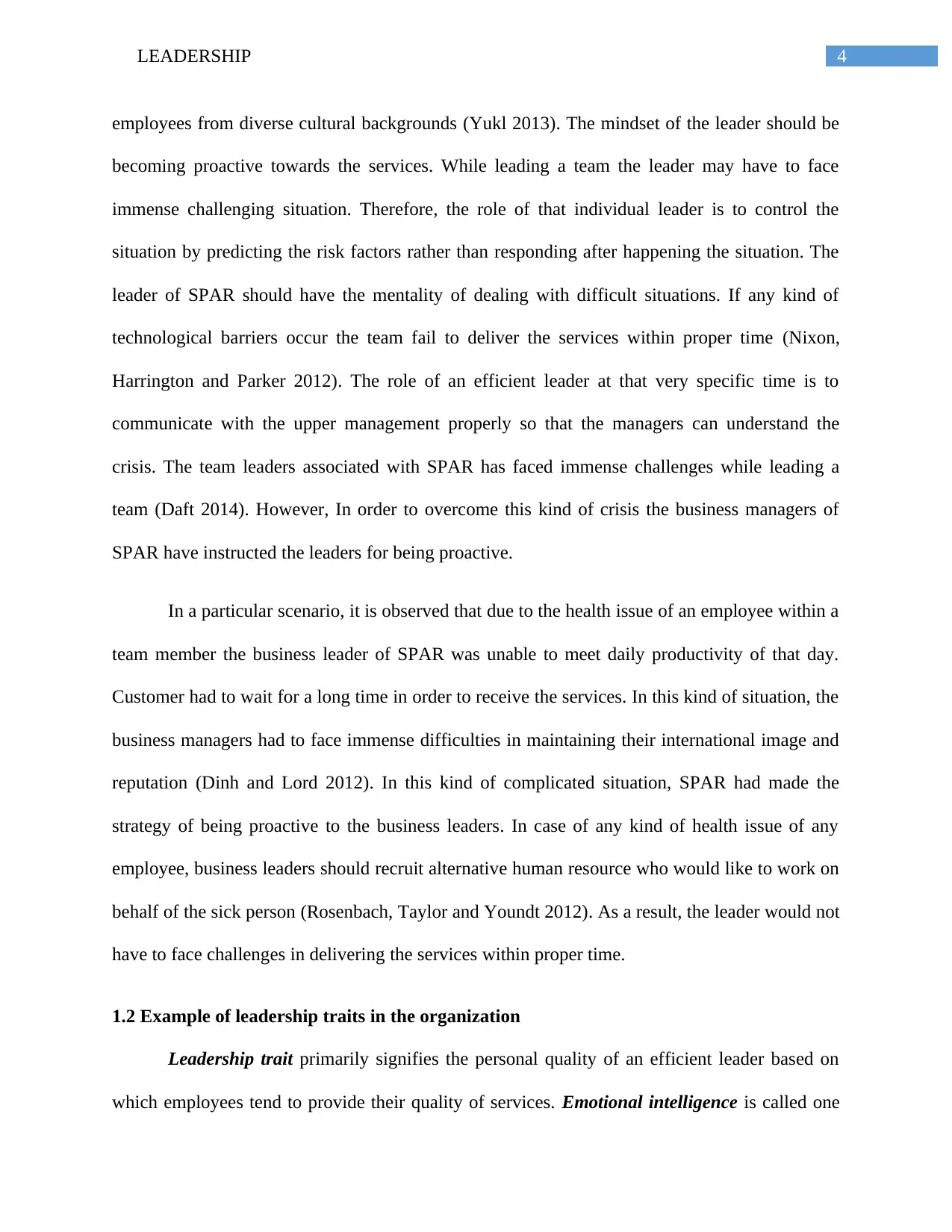
4LEADERSHIP
employees from diverse cultural backgrounds (Yukl 2013). The mindset of the leader should be
becoming proactive towards the services. While leading a team the leader may have to face
immense challenging situation. Therefore, the role of that individual leader is to control the
situation by predicting the risk factors rather than responding after happening the situation. The
leader of SPAR should have the mentality of dealing with difficult situations. If any kind of
technological barriers occur the team fail to deliver the services within proper time (Nixon,
Harrington and Parker 2012). The role of an efficient leader at that very specific time is to
communicate with the upper management properly so that the managers can understand the
crisis. The team leaders associated with SPAR has faced immense challenges while leading a
team (Daft 2014). However, In order to overcome this kind of crisis the business managers of
SPAR have instructed the leaders for being proactive.
In a particular scenario, it is observed that due to the health issue of an employee within a
team member the business leader of SPAR was unable to meet daily productivity of that day.
Customer had to wait for a long time in order to receive the services. In this kind of situation, the
business managers had to face immense difficulties in maintaining their international image and
reputation (Dinh and Lord 2012). In this kind of complicated situation, SPAR had made the
strategy of being proactive to the business leaders. In case of any kind of health issue of any
employee, business leaders should recruit alternative human resource who would like to work on
behalf of the sick person (Rosenbach, Taylor and Youndt 2012). As a result, the leader would not
have to face challenges in delivering the services within proper time.
1.2 Example of leadership traits in the organization
Leadership trait primarily signifies the personal quality of an efficient leader based on
which employees tend to provide their quality of services. Emotional intelligence is called one
employees from diverse cultural backgrounds (Yukl 2013). The mindset of the leader should be
becoming proactive towards the services. While leading a team the leader may have to face
immense challenging situation. Therefore, the role of that individual leader is to control the
situation by predicting the risk factors rather than responding after happening the situation. The
leader of SPAR should have the mentality of dealing with difficult situations. If any kind of
technological barriers occur the team fail to deliver the services within proper time (Nixon,
Harrington and Parker 2012). The role of an efficient leader at that very specific time is to
communicate with the upper management properly so that the managers can understand the
crisis. The team leaders associated with SPAR has faced immense challenges while leading a
team (Daft 2014). However, In order to overcome this kind of crisis the business managers of
SPAR have instructed the leaders for being proactive.
In a particular scenario, it is observed that due to the health issue of an employee within a
team member the business leader of SPAR was unable to meet daily productivity of that day.
Customer had to wait for a long time in order to receive the services. In this kind of situation, the
business managers had to face immense difficulties in maintaining their international image and
reputation (Dinh and Lord 2012). In this kind of complicated situation, SPAR had made the
strategy of being proactive to the business leaders. In case of any kind of health issue of any
employee, business leaders should recruit alternative human resource who would like to work on
behalf of the sick person (Rosenbach, Taylor and Youndt 2012). As a result, the leader would not
have to face challenges in delivering the services within proper time.
1.2 Example of leadership traits in the organization
Leadership trait primarily signifies the personal quality of an efficient leader based on
which employees tend to provide their quality of services. Emotional intelligence is called one
Paraphrase This Document
Need a fresh take? Get an instant paraphrase of this document with our AI Paraphraser
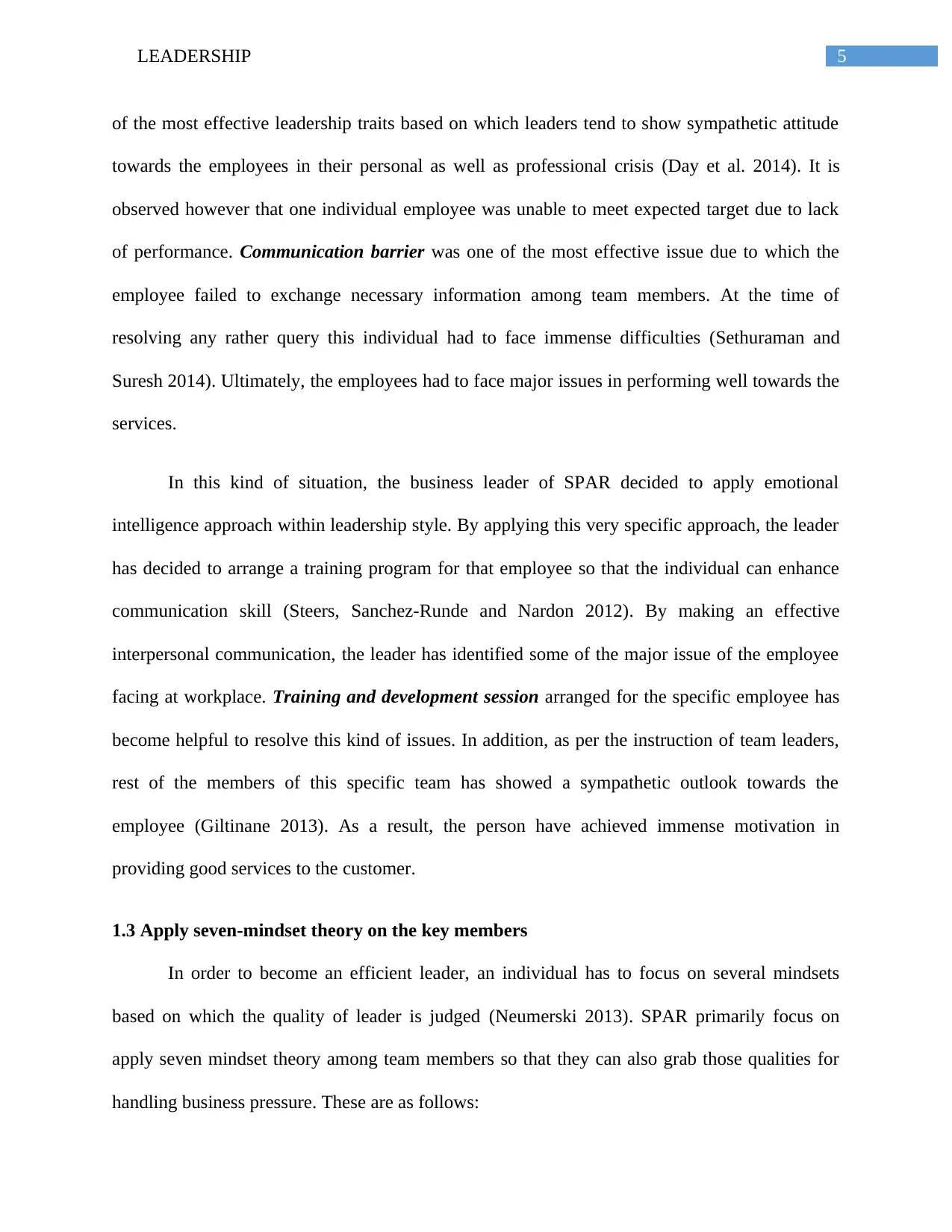
5LEADERSHIP
of the most effective leadership traits based on which leaders tend to show sympathetic attitude
towards the employees in their personal as well as professional crisis (Day et al. 2014). It is
observed however that one individual employee was unable to meet expected target due to lack
of performance. Communication barrier was one of the most effective issue due to which the
employee failed to exchange necessary information among team members. At the time of
resolving any rather query this individual had to face immense difficulties (Sethuraman and
Suresh 2014). Ultimately, the employees had to face major issues in performing well towards the
services.
In this kind of situation, the business leader of SPAR decided to apply emotional
intelligence approach within leadership style. By applying this very specific approach, the leader
has decided to arrange a training program for that employee so that the individual can enhance
communication skill (Steers, Sanchez-Runde and Nardon 2012). By making an effective
interpersonal communication, the leader has identified some of the major issue of the employee
facing at workplace. Training and development session arranged for the specific employee has
become helpful to resolve this kind of issues. In addition, as per the instruction of team leaders,
rest of the members of this specific team has showed a sympathetic outlook towards the
employee (Giltinane 2013). As a result, the person have achieved immense motivation in
providing good services to the customer.
1.3 Apply seven-mindset theory on the key members
In order to become an efficient leader, an individual has to focus on several mindsets
based on which the quality of leader is judged (Neumerski 2013). SPAR primarily focus on
apply seven mindset theory among team members so that they can also grab those qualities for
handling business pressure. These are as follows:
of the most effective leadership traits based on which leaders tend to show sympathetic attitude
towards the employees in their personal as well as professional crisis (Day et al. 2014). It is
observed however that one individual employee was unable to meet expected target due to lack
of performance. Communication barrier was one of the most effective issue due to which the
employee failed to exchange necessary information among team members. At the time of
resolving any rather query this individual had to face immense difficulties (Sethuraman and
Suresh 2014). Ultimately, the employees had to face major issues in performing well towards the
services.
In this kind of situation, the business leader of SPAR decided to apply emotional
intelligence approach within leadership style. By applying this very specific approach, the leader
has decided to arrange a training program for that employee so that the individual can enhance
communication skill (Steers, Sanchez-Runde and Nardon 2012). By making an effective
interpersonal communication, the leader has identified some of the major issue of the employee
facing at workplace. Training and development session arranged for the specific employee has
become helpful to resolve this kind of issues. In addition, as per the instruction of team leaders,
rest of the members of this specific team has showed a sympathetic outlook towards the
employee (Giltinane 2013). As a result, the person have achieved immense motivation in
providing good services to the customer.
1.3 Apply seven-mindset theory on the key members
In order to become an efficient leader, an individual has to focus on several mindsets
based on which the quality of leader is judged (Neumerski 2013). SPAR primarily focus on
apply seven mindset theory among team members so that they can also grab those qualities for
handling business pressure. These are as follows:
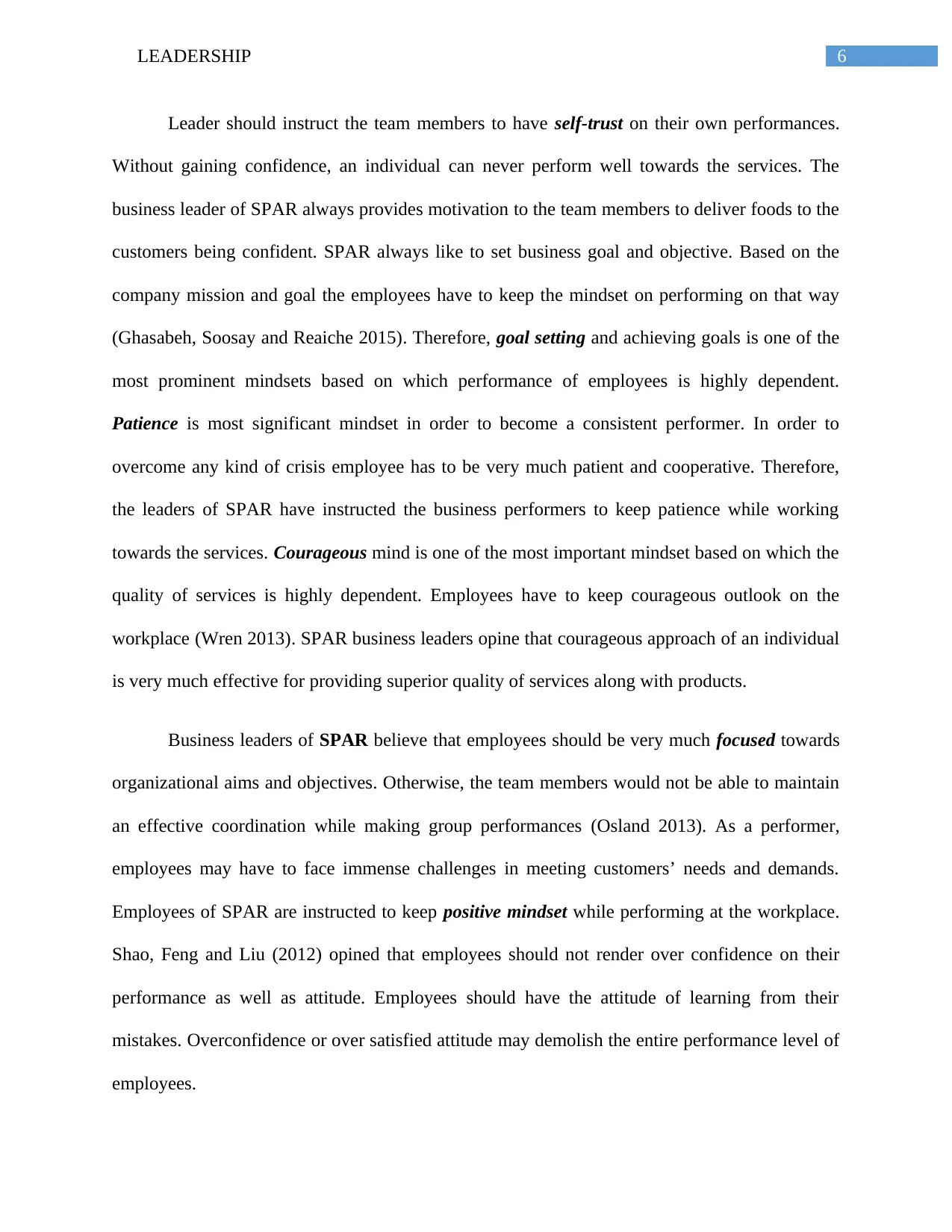
6LEADERSHIP
Leader should instruct the team members to have self-trust on their own performances.
Without gaining confidence, an individual can never perform well towards the services. The
business leader of SPAR always provides motivation to the team members to deliver foods to the
customers being confident. SPAR always like to set business goal and objective. Based on the
company mission and goal the employees have to keep the mindset on performing on that way
(Ghasabeh, Soosay and Reaiche 2015). Therefore, goal setting and achieving goals is one of the
most prominent mindsets based on which performance of employees is highly dependent.
Patience is most significant mindset in order to become a consistent performer. In order to
overcome any kind of crisis employee has to be very much patient and cooperative. Therefore,
the leaders of SPAR have instructed the business performers to keep patience while working
towards the services. Courageous mind is one of the most important mindset based on which the
quality of services is highly dependent. Employees have to keep courageous outlook on the
workplace (Wren 2013). SPAR business leaders opine that courageous approach of an individual
is very much effective for providing superior quality of services along with products.
Business leaders of SPAR believe that employees should be very much focused towards
organizational aims and objectives. Otherwise, the team members would not be able to maintain
an effective coordination while making group performances (Osland 2013). As a performer,
employees may have to face immense challenges in meeting customers’ needs and demands.
Employees of SPAR are instructed to keep positive mindset while performing at the workplace.
Shao, Feng and Liu (2012) opined that employees should not render over confidence on their
performance as well as attitude. Employees should have the attitude of learning from their
mistakes. Overconfidence or over satisfied attitude may demolish the entire performance level of
employees.
Leader should instruct the team members to have self-trust on their own performances.
Without gaining confidence, an individual can never perform well towards the services. The
business leader of SPAR always provides motivation to the team members to deliver foods to the
customers being confident. SPAR always like to set business goal and objective. Based on the
company mission and goal the employees have to keep the mindset on performing on that way
(Ghasabeh, Soosay and Reaiche 2015). Therefore, goal setting and achieving goals is one of the
most prominent mindsets based on which performance of employees is highly dependent.
Patience is most significant mindset in order to become a consistent performer. In order to
overcome any kind of crisis employee has to be very much patient and cooperative. Therefore,
the leaders of SPAR have instructed the business performers to keep patience while working
towards the services. Courageous mind is one of the most important mindset based on which the
quality of services is highly dependent. Employees have to keep courageous outlook on the
workplace (Wren 2013). SPAR business leaders opine that courageous approach of an individual
is very much effective for providing superior quality of services along with products.
Business leaders of SPAR believe that employees should be very much focused towards
organizational aims and objectives. Otherwise, the team members would not be able to maintain
an effective coordination while making group performances (Osland 2013). As a performer,
employees may have to face immense challenges in meeting customers’ needs and demands.
Employees of SPAR are instructed to keep positive mindset while performing at the workplace.
Shao, Feng and Liu (2012) opined that employees should not render over confidence on their
performance as well as attitude. Employees should have the attitude of learning from their
mistakes. Overconfidence or over satisfied attitude may demolish the entire performance level of
employees.
⊘ This is a preview!⊘
Do you want full access?
Subscribe today to unlock all pages.

Trusted by 1+ million students worldwide
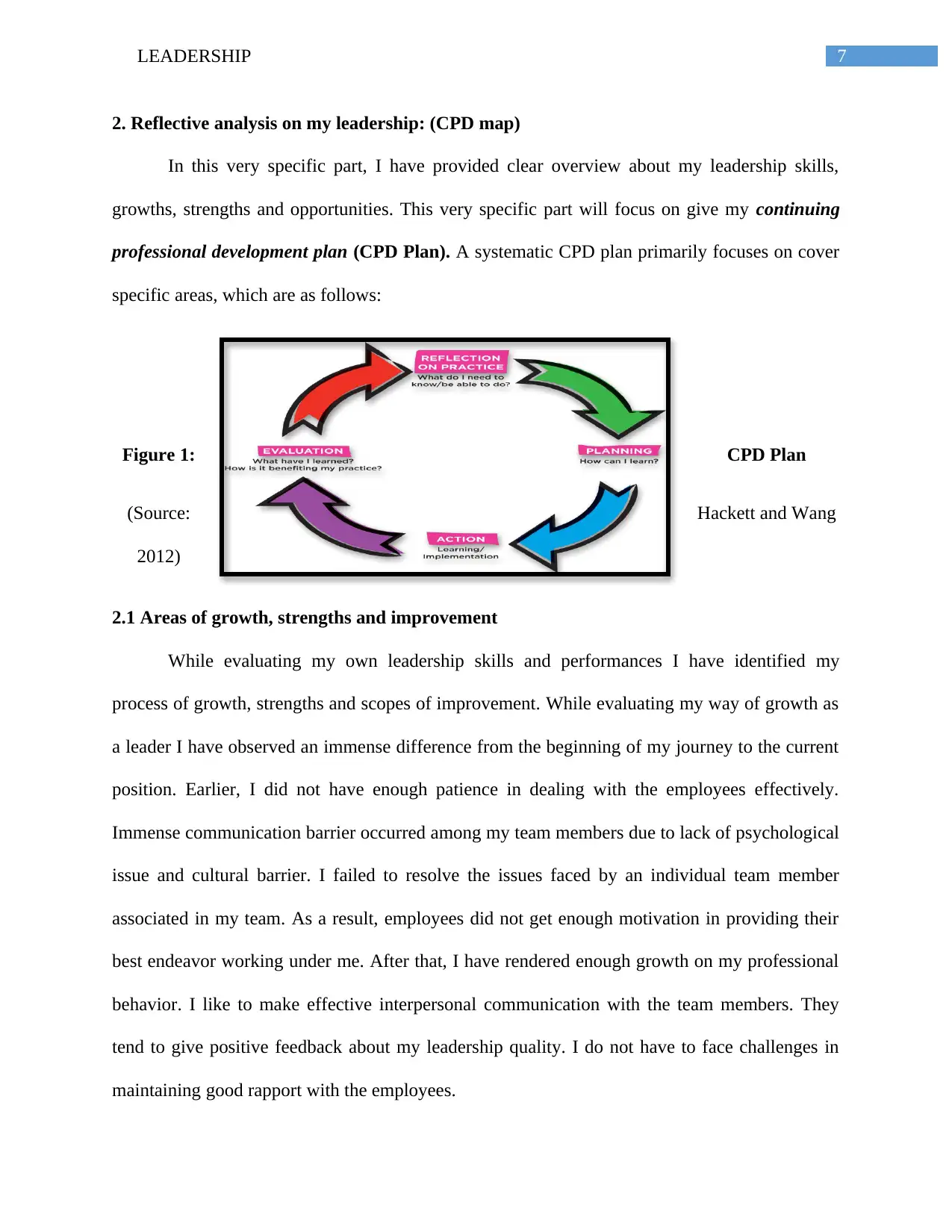
7LEADERSHIP
2. Reflective analysis on my leadership: (CPD map)
In this very specific part, I have provided clear overview about my leadership skills,
growths, strengths and opportunities. This very specific part will focus on give my continuing
professional development plan (CPD Plan). A systematic CPD plan primarily focuses on cover
specific areas, which are as follows:
Figure 1: CPD Plan
(Source: Hackett and Wang
2012)
2.1 Areas of growth, strengths and improvement
While evaluating my own leadership skills and performances I have identified my
process of growth, strengths and scopes of improvement. While evaluating my way of growth as
a leader I have observed an immense difference from the beginning of my journey to the current
position. Earlier, I did not have enough patience in dealing with the employees effectively.
Immense communication barrier occurred among my team members due to lack of psychological
issue and cultural barrier. I failed to resolve the issues faced by an individual team member
associated in my team. As a result, employees did not get enough motivation in providing their
best endeavor working under me. After that, I have rendered enough growth on my professional
behavior. I like to make effective interpersonal communication with the team members. They
tend to give positive feedback about my leadership quality. I do not have to face challenges in
maintaining good rapport with the employees.
2. Reflective analysis on my leadership: (CPD map)
In this very specific part, I have provided clear overview about my leadership skills,
growths, strengths and opportunities. This very specific part will focus on give my continuing
professional development plan (CPD Plan). A systematic CPD plan primarily focuses on cover
specific areas, which are as follows:
Figure 1: CPD Plan
(Source: Hackett and Wang
2012)
2.1 Areas of growth, strengths and improvement
While evaluating my own leadership skills and performances I have identified my
process of growth, strengths and scopes of improvement. While evaluating my way of growth as
a leader I have observed an immense difference from the beginning of my journey to the current
position. Earlier, I did not have enough patience in dealing with the employees effectively.
Immense communication barrier occurred among my team members due to lack of psychological
issue and cultural barrier. I failed to resolve the issues faced by an individual team member
associated in my team. As a result, employees did not get enough motivation in providing their
best endeavor working under me. After that, I have rendered enough growth on my professional
behavior. I like to make effective interpersonal communication with the team members. They
tend to give positive feedback about my leadership quality. I do not have to face challenges in
maintaining good rapport with the employees.
Paraphrase This Document
Need a fresh take? Get an instant paraphrase of this document with our AI Paraphraser
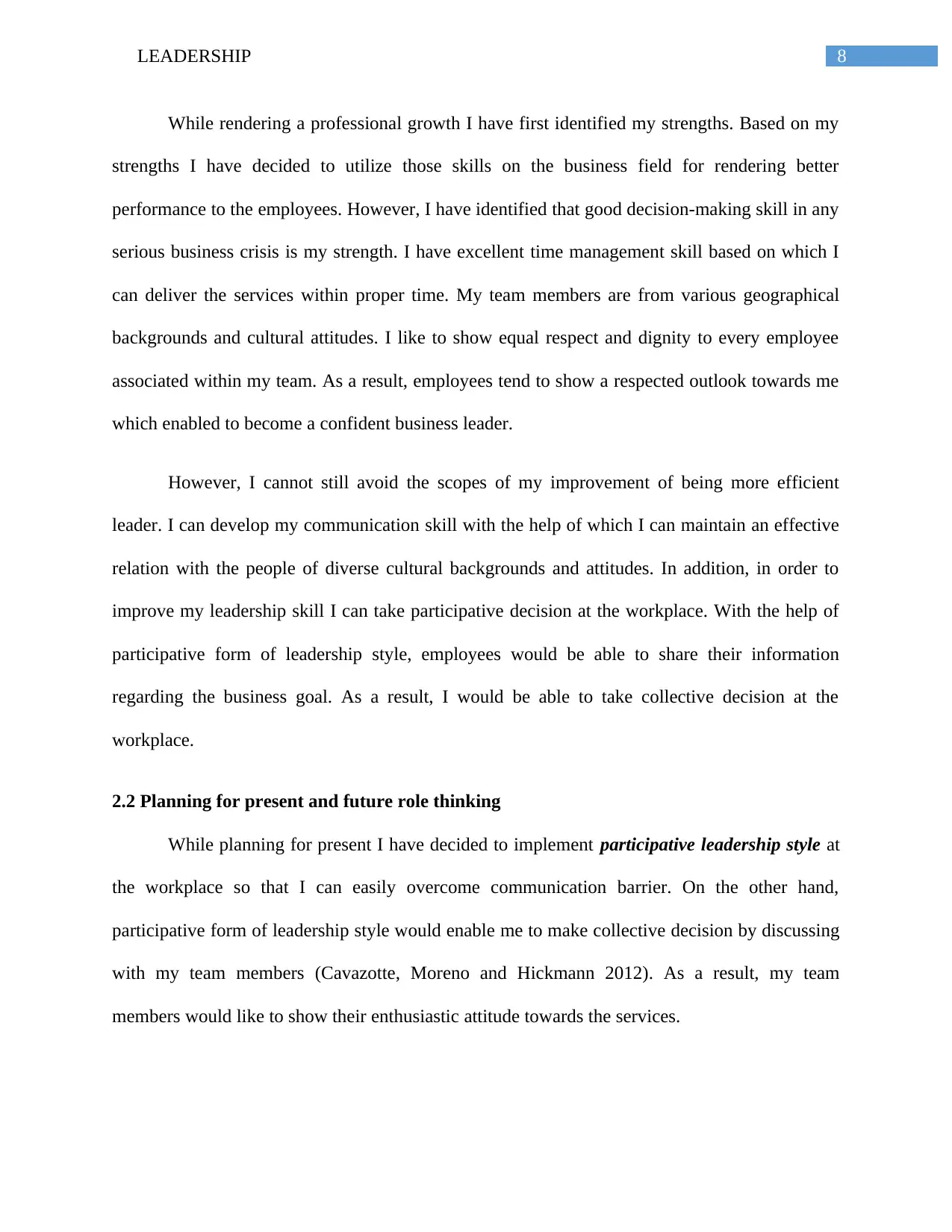
8LEADERSHIP
While rendering a professional growth I have first identified my strengths. Based on my
strengths I have decided to utilize those skills on the business field for rendering better
performance to the employees. However, I have identified that good decision-making skill in any
serious business crisis is my strength. I have excellent time management skill based on which I
can deliver the services within proper time. My team members are from various geographical
backgrounds and cultural attitudes. I like to show equal respect and dignity to every employee
associated within my team. As a result, employees tend to show a respected outlook towards me
which enabled to become a confident business leader.
However, I cannot still avoid the scopes of my improvement of being more efficient
leader. I can develop my communication skill with the help of which I can maintain an effective
relation with the people of diverse cultural backgrounds and attitudes. In addition, in order to
improve my leadership skill I can take participative decision at the workplace. With the help of
participative form of leadership style, employees would be able to share their information
regarding the business goal. As a result, I would be able to take collective decision at the
workplace.
2.2 Planning for present and future role thinking
While planning for present I have decided to implement participative leadership style at
the workplace so that I can easily overcome communication barrier. On the other hand,
participative form of leadership style would enable me to make collective decision by discussing
with my team members (Cavazotte, Moreno and Hickmann 2012). As a result, my team
members would like to show their enthusiastic attitude towards the services.
While rendering a professional growth I have first identified my strengths. Based on my
strengths I have decided to utilize those skills on the business field for rendering better
performance to the employees. However, I have identified that good decision-making skill in any
serious business crisis is my strength. I have excellent time management skill based on which I
can deliver the services within proper time. My team members are from various geographical
backgrounds and cultural attitudes. I like to show equal respect and dignity to every employee
associated within my team. As a result, employees tend to show a respected outlook towards me
which enabled to become a confident business leader.
However, I cannot still avoid the scopes of my improvement of being more efficient
leader. I can develop my communication skill with the help of which I can maintain an effective
relation with the people of diverse cultural backgrounds and attitudes. In addition, in order to
improve my leadership skill I can take participative decision at the workplace. With the help of
participative form of leadership style, employees would be able to share their information
regarding the business goal. As a result, I would be able to take collective decision at the
workplace.
2.2 Planning for present and future role thinking
While planning for present I have decided to implement participative leadership style at
the workplace so that I can easily overcome communication barrier. On the other hand,
participative form of leadership style would enable me to make collective decision by discussing
with my team members (Cavazotte, Moreno and Hickmann 2012). As a result, my team
members would like to show their enthusiastic attitude towards the services.
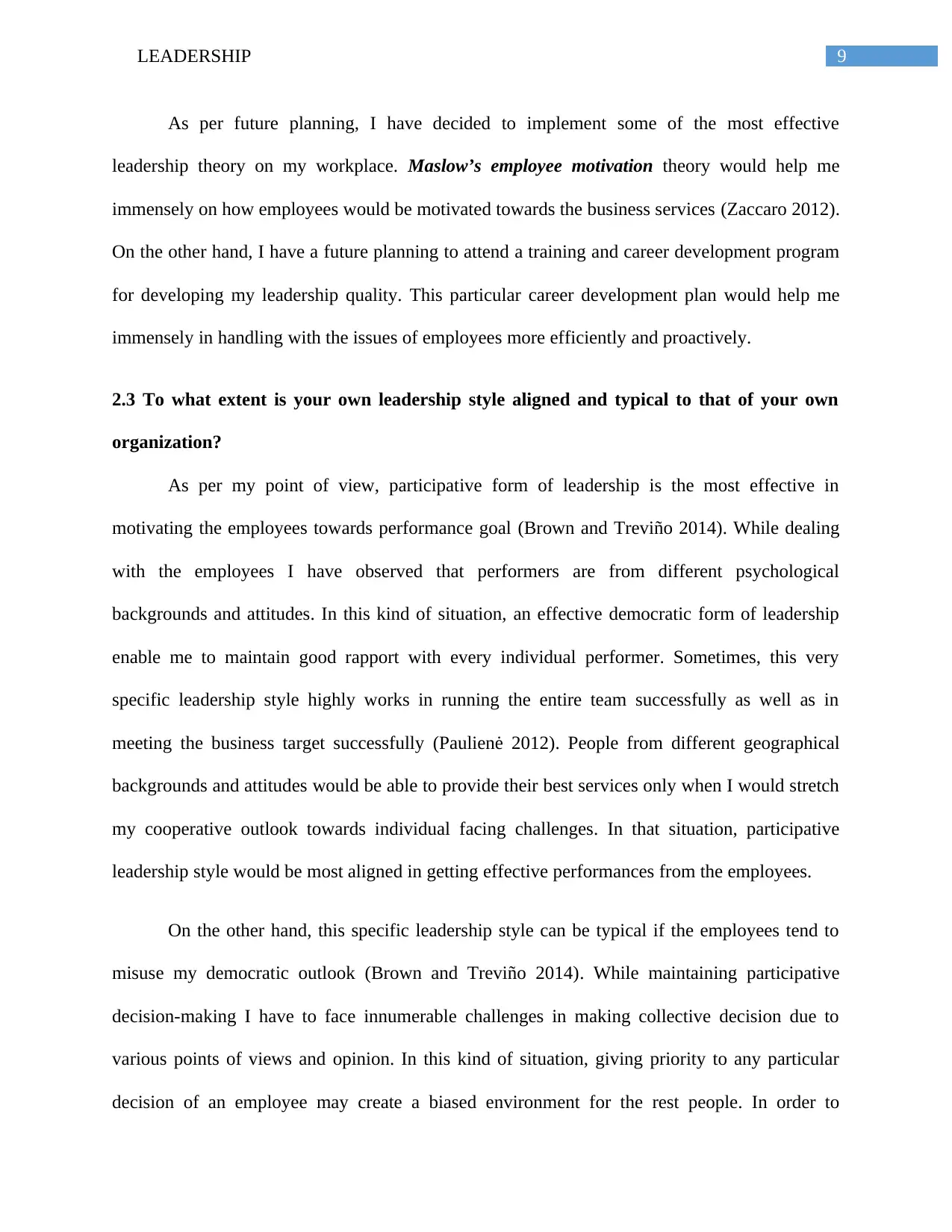
9LEADERSHIP
As per future planning, I have decided to implement some of the most effective
leadership theory on my workplace. Maslow’s employee motivation theory would help me
immensely on how employees would be motivated towards the business services (Zaccaro 2012).
On the other hand, I have a future planning to attend a training and career development program
for developing my leadership quality. This particular career development plan would help me
immensely in handling with the issues of employees more efficiently and proactively.
2.3 To what extent is your own leadership style aligned and typical to that of your own
organization?
As per my point of view, participative form of leadership is the most effective in
motivating the employees towards performance goal (Brown and Treviño 2014). While dealing
with the employees I have observed that performers are from different psychological
backgrounds and attitudes. In this kind of situation, an effective democratic form of leadership
enable me to maintain good rapport with every individual performer. Sometimes, this very
specific leadership style highly works in running the entire team successfully as well as in
meeting the business target successfully (Paulienė 2012). People from different geographical
backgrounds and attitudes would be able to provide their best services only when I would stretch
my cooperative outlook towards individual facing challenges. In that situation, participative
leadership style would be most aligned in getting effective performances from the employees.
On the other hand, this specific leadership style can be typical if the employees tend to
misuse my democratic outlook (Brown and Treviño 2014). While maintaining participative
decision-making I have to face innumerable challenges in making collective decision due to
various points of views and opinion. In this kind of situation, giving priority to any particular
decision of an employee may create a biased environment for the rest people. In order to
As per future planning, I have decided to implement some of the most effective
leadership theory on my workplace. Maslow’s employee motivation theory would help me
immensely on how employees would be motivated towards the business services (Zaccaro 2012).
On the other hand, I have a future planning to attend a training and career development program
for developing my leadership quality. This particular career development plan would help me
immensely in handling with the issues of employees more efficiently and proactively.
2.3 To what extent is your own leadership style aligned and typical to that of your own
organization?
As per my point of view, participative form of leadership is the most effective in
motivating the employees towards performance goal (Brown and Treviño 2014). While dealing
with the employees I have observed that performers are from different psychological
backgrounds and attitudes. In this kind of situation, an effective democratic form of leadership
enable me to maintain good rapport with every individual performer. Sometimes, this very
specific leadership style highly works in running the entire team successfully as well as in
meeting the business target successfully (Paulienė 2012). People from different geographical
backgrounds and attitudes would be able to provide their best services only when I would stretch
my cooperative outlook towards individual facing challenges. In that situation, participative
leadership style would be most aligned in getting effective performances from the employees.
On the other hand, this specific leadership style can be typical if the employees tend to
misuse my democratic outlook (Brown and Treviño 2014). While maintaining participative
decision-making I have to face innumerable challenges in making collective decision due to
various points of views and opinion. In this kind of situation, giving priority to any particular
decision of an employee may create a biased environment for the rest people. In order to
⊘ This is a preview!⊘
Do you want full access?
Subscribe today to unlock all pages.

Trusted by 1+ million students worldwide
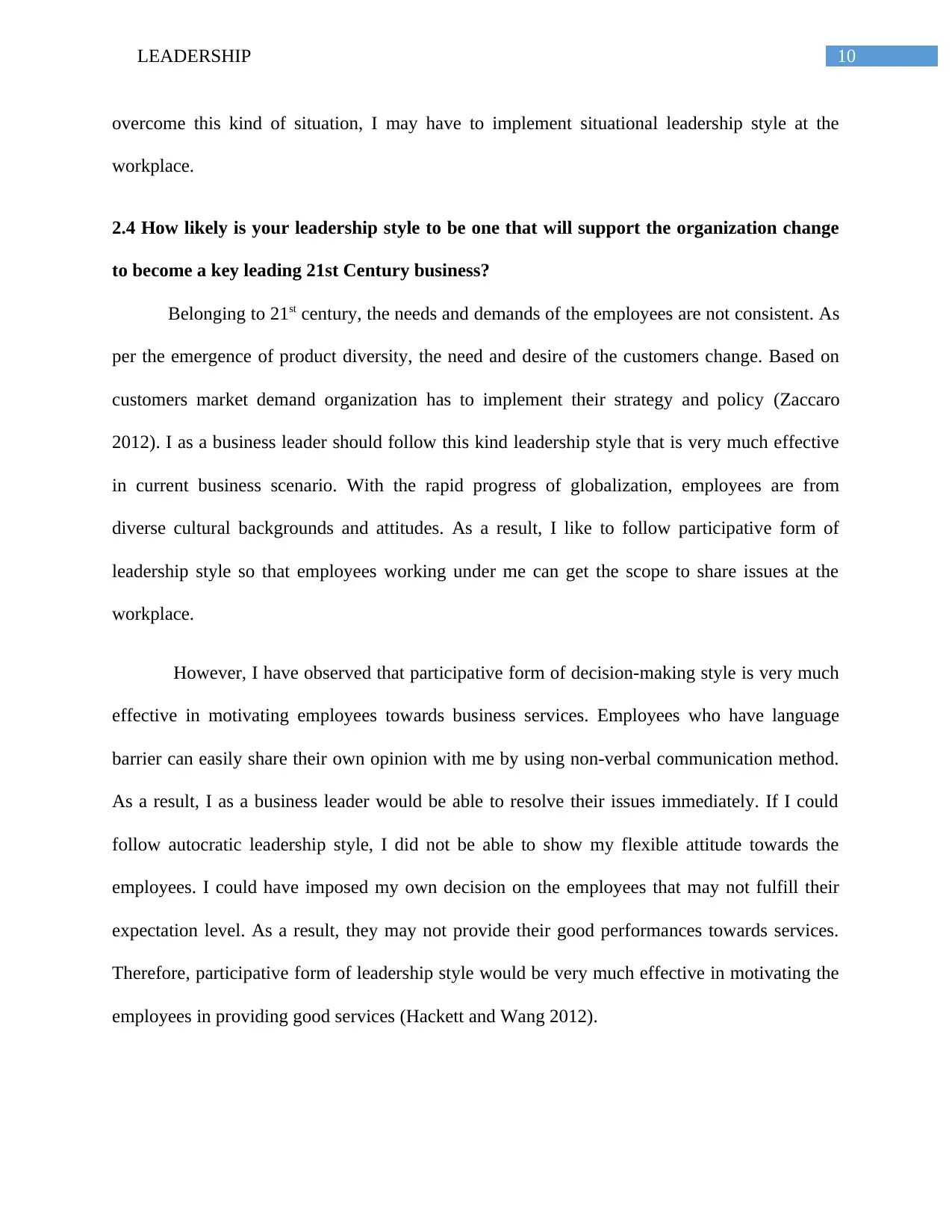
10LEADERSHIP
overcome this kind of situation, I may have to implement situational leadership style at the
workplace.
2.4 How likely is your leadership style to be one that will support the organization change
to become a key leading 21st Century business?
Belonging to 21st century, the needs and demands of the employees are not consistent. As
per the emergence of product diversity, the need and desire of the customers change. Based on
customers market demand organization has to implement their strategy and policy (Zaccaro
2012). I as a business leader should follow this kind leadership style that is very much effective
in current business scenario. With the rapid progress of globalization, employees are from
diverse cultural backgrounds and attitudes. As a result, I like to follow participative form of
leadership style so that employees working under me can get the scope to share issues at the
workplace.
However, I have observed that participative form of decision-making style is very much
effective in motivating employees towards business services. Employees who have language
barrier can easily share their own opinion with me by using non-verbal communication method.
As a result, I as a business leader would be able to resolve their issues immediately. If I could
follow autocratic leadership style, I did not be able to show my flexible attitude towards the
employees. I could have imposed my own decision on the employees that may not fulfill their
expectation level. As a result, they may not provide their good performances towards services.
Therefore, participative form of leadership style would be very much effective in motivating the
employees in providing good services (Hackett and Wang 2012).
overcome this kind of situation, I may have to implement situational leadership style at the
workplace.
2.4 How likely is your leadership style to be one that will support the organization change
to become a key leading 21st Century business?
Belonging to 21st century, the needs and demands of the employees are not consistent. As
per the emergence of product diversity, the need and desire of the customers change. Based on
customers market demand organization has to implement their strategy and policy (Zaccaro
2012). I as a business leader should follow this kind leadership style that is very much effective
in current business scenario. With the rapid progress of globalization, employees are from
diverse cultural backgrounds and attitudes. As a result, I like to follow participative form of
leadership style so that employees working under me can get the scope to share issues at the
workplace.
However, I have observed that participative form of decision-making style is very much
effective in motivating employees towards business services. Employees who have language
barrier can easily share their own opinion with me by using non-verbal communication method.
As a result, I as a business leader would be able to resolve their issues immediately. If I could
follow autocratic leadership style, I did not be able to show my flexible attitude towards the
employees. I could have imposed my own decision on the employees that may not fulfill their
expectation level. As a result, they may not provide their good performances towards services.
Therefore, participative form of leadership style would be very much effective in motivating the
employees in providing good services (Hackett and Wang 2012).
Paraphrase This Document
Need a fresh take? Get an instant paraphrase of this document with our AI Paraphraser
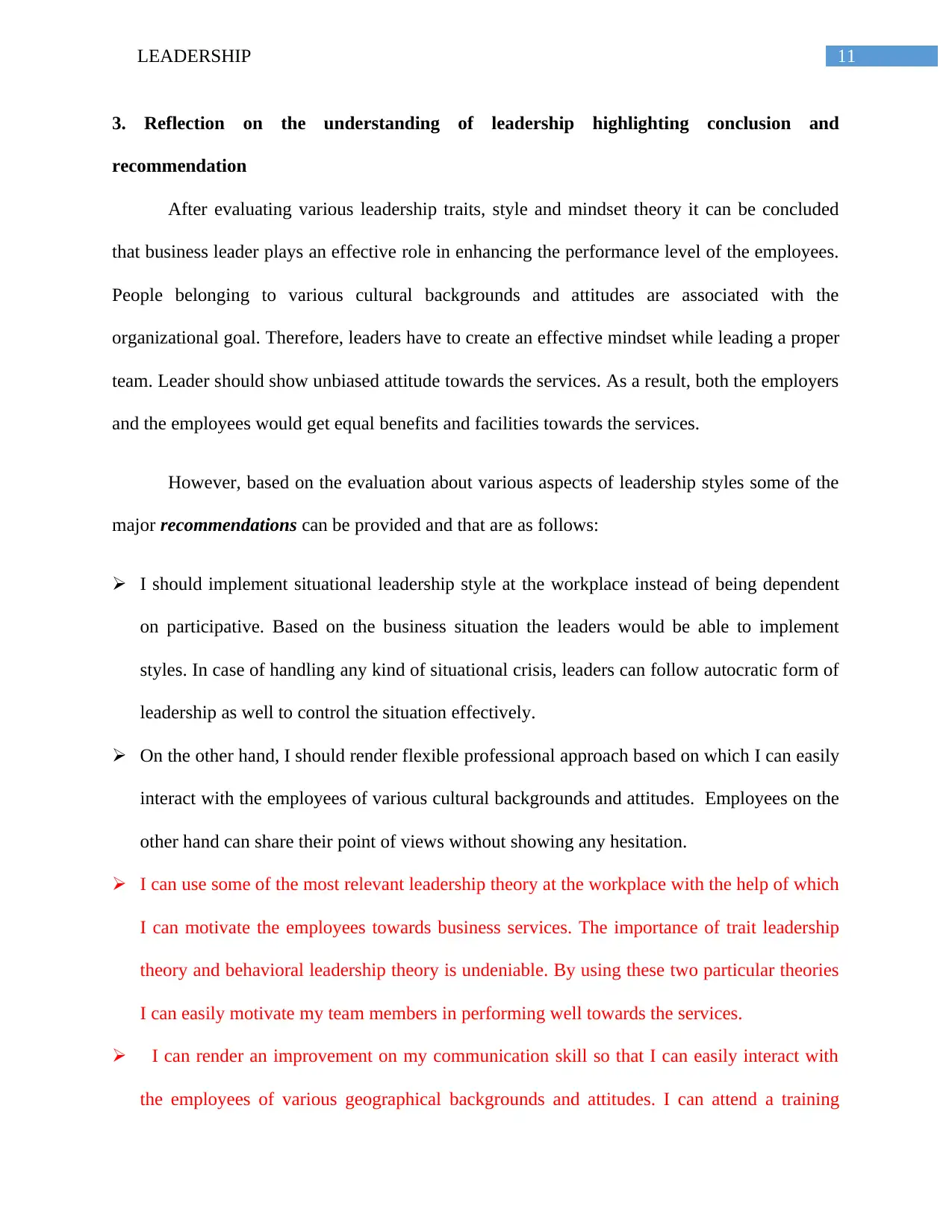
11LEADERSHIP
3. Reflection on the understanding of leadership highlighting conclusion and
recommendation
After evaluating various leadership traits, style and mindset theory it can be concluded
that business leader plays an effective role in enhancing the performance level of the employees.
People belonging to various cultural backgrounds and attitudes are associated with the
organizational goal. Therefore, leaders have to create an effective mindset while leading a proper
team. Leader should show unbiased attitude towards the services. As a result, both the employers
and the employees would get equal benefits and facilities towards the services.
However, based on the evaluation about various aspects of leadership styles some of the
major recommendations can be provided and that are as follows:
I should implement situational leadership style at the workplace instead of being dependent
on participative. Based on the business situation the leaders would be able to implement
styles. In case of handling any kind of situational crisis, leaders can follow autocratic form of
leadership as well to control the situation effectively.
On the other hand, I should render flexible professional approach based on which I can easily
interact with the employees of various cultural backgrounds and attitudes. Employees on the
other hand can share their point of views without showing any hesitation.
I can use some of the most relevant leadership theory at the workplace with the help of which
I can motivate the employees towards business services. The importance of trait leadership
theory and behavioral leadership theory is undeniable. By using these two particular theories
I can easily motivate my team members in performing well towards the services.
I can render an improvement on my communication skill so that I can easily interact with
the employees of various geographical backgrounds and attitudes. I can attend a training
3. Reflection on the understanding of leadership highlighting conclusion and
recommendation
After evaluating various leadership traits, style and mindset theory it can be concluded
that business leader plays an effective role in enhancing the performance level of the employees.
People belonging to various cultural backgrounds and attitudes are associated with the
organizational goal. Therefore, leaders have to create an effective mindset while leading a proper
team. Leader should show unbiased attitude towards the services. As a result, both the employers
and the employees would get equal benefits and facilities towards the services.
However, based on the evaluation about various aspects of leadership styles some of the
major recommendations can be provided and that are as follows:
I should implement situational leadership style at the workplace instead of being dependent
on participative. Based on the business situation the leaders would be able to implement
styles. In case of handling any kind of situational crisis, leaders can follow autocratic form of
leadership as well to control the situation effectively.
On the other hand, I should render flexible professional approach based on which I can easily
interact with the employees of various cultural backgrounds and attitudes. Employees on the
other hand can share their point of views without showing any hesitation.
I can use some of the most relevant leadership theory at the workplace with the help of which
I can motivate the employees towards business services. The importance of trait leadership
theory and behavioral leadership theory is undeniable. By using these two particular theories
I can easily motivate my team members in performing well towards the services.
I can render an improvement on my communication skill so that I can easily interact with
the employees of various geographical backgrounds and attitudes. I can attend a training
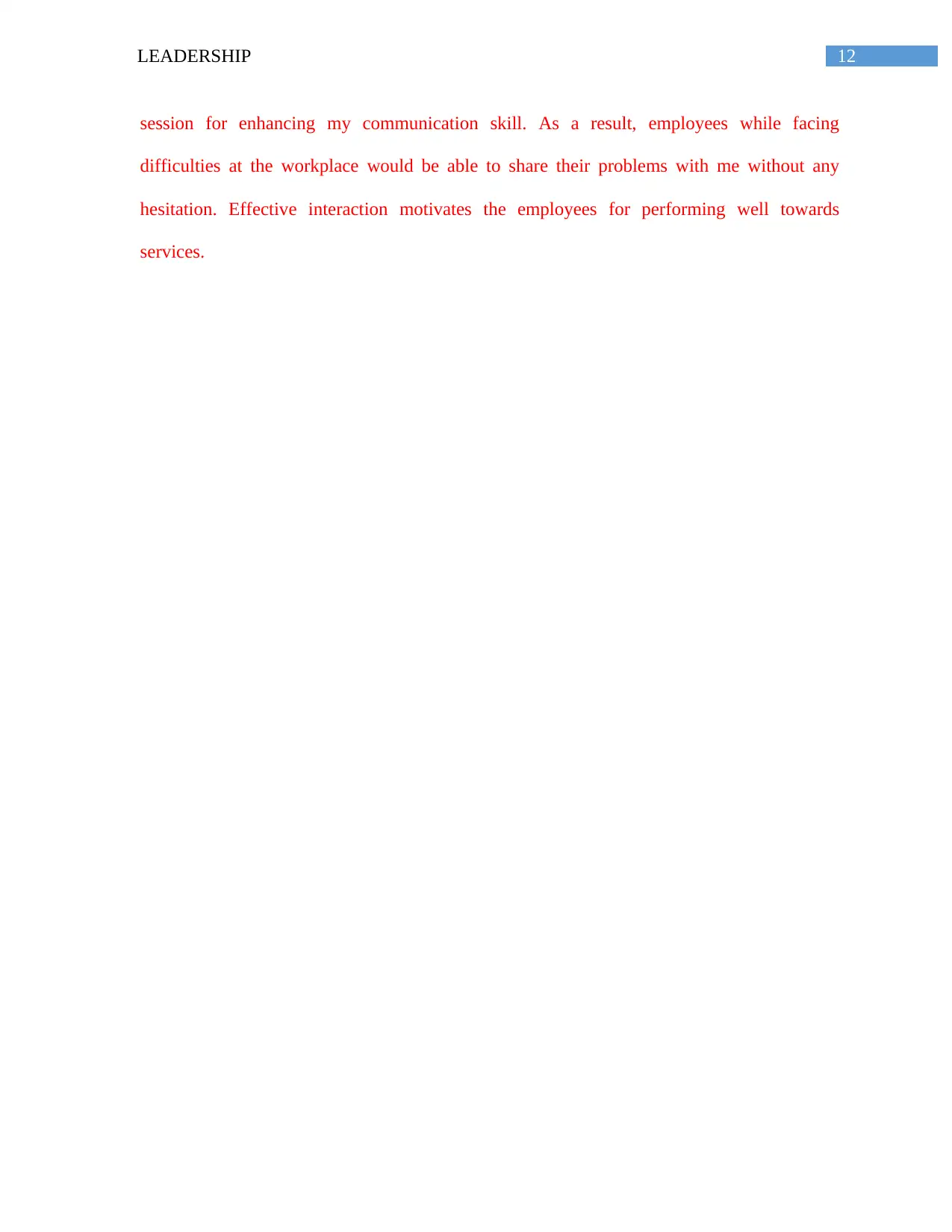
12LEADERSHIP
session for enhancing my communication skill. As a result, employees while facing
difficulties at the workplace would be able to share their problems with me without any
hesitation. Effective interaction motivates the employees for performing well towards
services.
session for enhancing my communication skill. As a result, employees while facing
difficulties at the workplace would be able to share their problems with me without any
hesitation. Effective interaction motivates the employees for performing well towards
services.
⊘ This is a preview!⊘
Do you want full access?
Subscribe today to unlock all pages.

Trusted by 1+ million students worldwide
1 out of 15
Related Documents
Your All-in-One AI-Powered Toolkit for Academic Success.
+13062052269
info@desklib.com
Available 24*7 on WhatsApp / Email
![[object Object]](/_next/static/media/star-bottom.7253800d.svg)
Unlock your academic potential
Copyright © 2020–2025 A2Z Services. All Rights Reserved. Developed and managed by ZUCOL.




